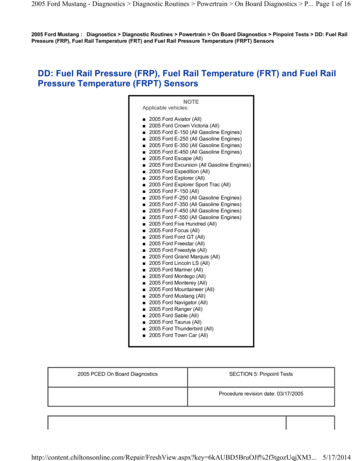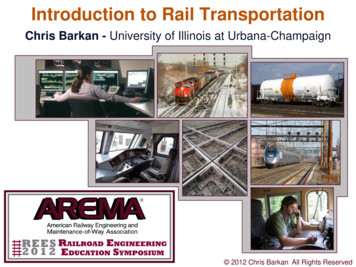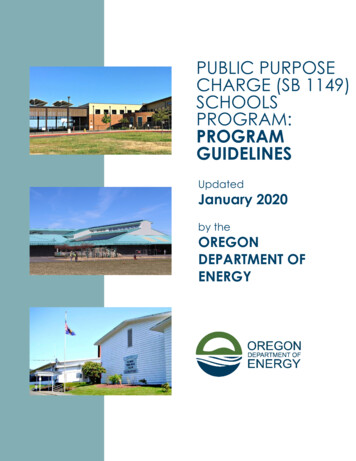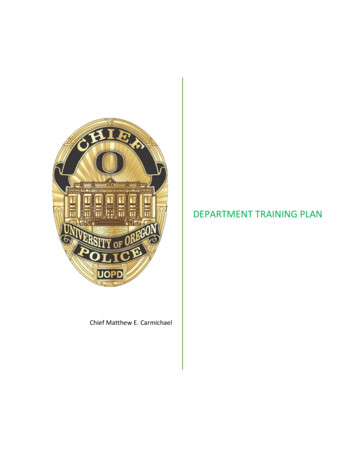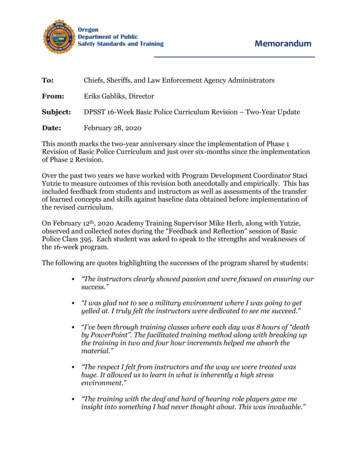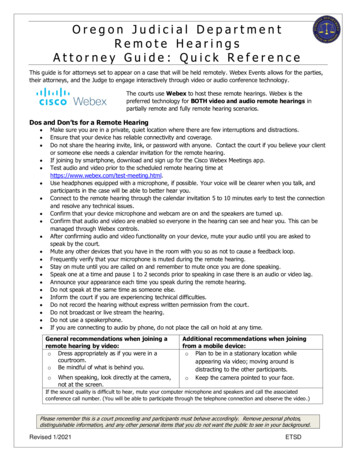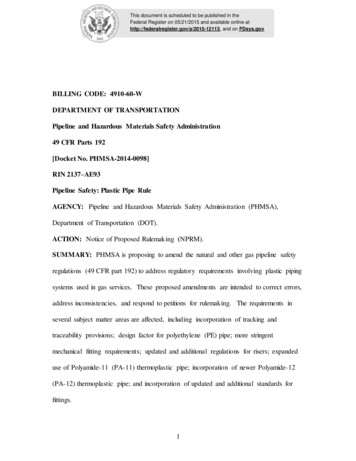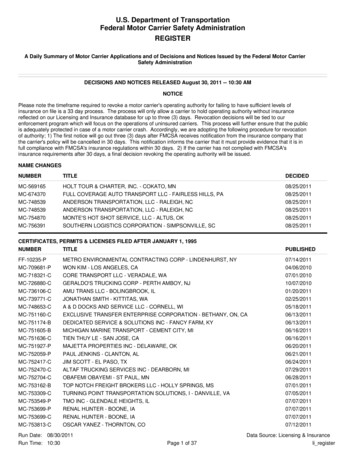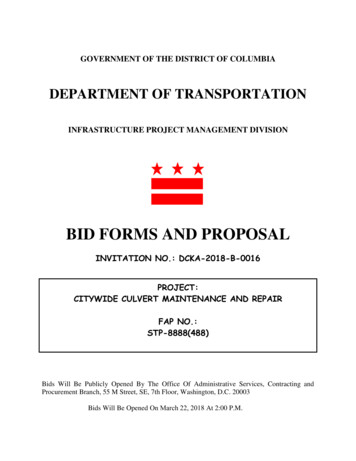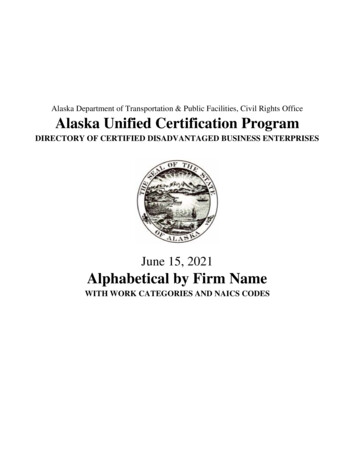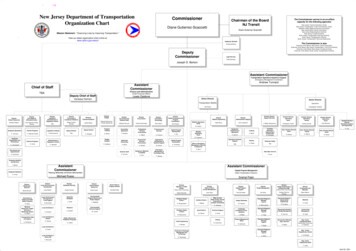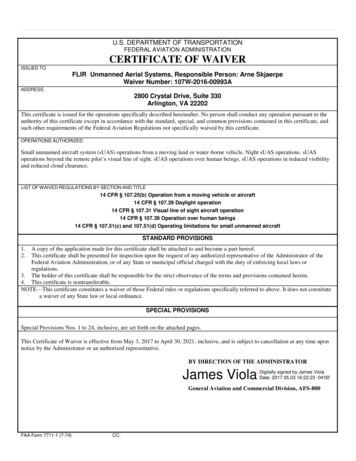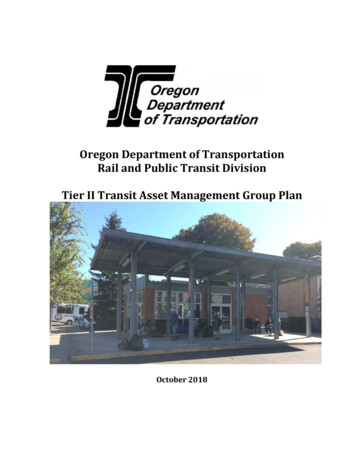
Transcription
Oregon Department of TransportationRail and Public Transit DivisionTier II Transit Asset Management Group PlanOctober 2018
TABLE OF CONTENTSIntroduction . 1Background. 1Transit Asset Management Plan Requirements . 2Definitions . 3Tier II Transit Systems . 8Benchmarks . 8TAM Plan Inclusion . 9Vehicle Classifications . 10Asset Inventory . 10Data Collection . 10Condition Assessments . 12Rolling Stock and Equipment . 12Facilities . 14Decision Support Tools. 16Investment Prioritization . 19Appendix 1 Rolling Stock Inventory by Subrecipient . 30Appendix 2 Facility Inventory by Subrecipient . 43
INTRODUCTIONIn 2016, the Federal Transit Administration (FTA) published a rule, 49 CFR Part 625, to requirepublic transit providers that receive Federal transit assistance to undertake certain transit assetmanagement activities. Transit asset management is the strategic and systematic practice ofprocuring, operating, inspecting, maintaining, rehabilitating, and replacing transit capital assetsto manage their performance, risks, and costs over their life cycles, for the purpose of providingsafe, cost-effective, and reliable public transportation. Asset management is a cornerstone ofeffective performance management. By leveraging data to improve investment decision-making,asset management improves reliability, safety, cost management, and customer service.BACKGROUNDMaintaining transit assets, such as rolling stock, infrastructure, equipment, and facilities, in astate of good repair is essential to maintaining safety, ensuring system reliability, and reducinglong-term maintenance costs. In its 2010 National State of Good Repair Assessment, FTA foundthat more than 40% of bus assets and 25% of rail transit assets were in marginal or poorcondition. There is an estimated backlog of 50– 80 billion in deferred maintenance andreplacement needs, a backlog that continues to grow. Transit agency customers, policymakers,and public agencies are holding agency management accountable for performance andincreasingly expect more business-like management practices. The magnitude of these capitalneeds, performance expectations, and increased accountability requires agency managers andaccountable executives to become better asset managers.MAP-21 required the establishment of a National Transit Asset Management (TAM) System thatwould include a definition of “state of good repair;” requirements that recipients andsubrecipients of federal transit funding develop transit asset management plans; state of goodrepair performance measure and reporting requirements; and annual reporting requirements.To ensure compliance with the requirements of MAP-21, the FTA published a final rule on TAMplanning requirements on July 26, 2016. The final rule included a transit-specific assetmanagement framework for managing assets individually and as a portfolio of assets thatcomprise an integrated system. Within that framework, the FTA has identified three potentialroles in transit asset management planning:Tier I Provider is a recipient that owns, operates, or manages either (1) one hundred andone (101) or more vehicles in revenue service during peak regular service across all fixedroute modes or in any one non-fixed route mode, or (2) rail transit. Tier I providers mustdevelop their own, individual TAM plan.Tier II Provider is a recipient that owns, operates, or manages (1) one hundred (100) orfewer vehicles in revenue service during peak regular service across all non-rail fixed routemodes or in any one non-fixed route mode, (2) a subrecipient under the 5311 Rural AreaFormula Program, (3) or any American Indian tribe. Tier II providers can develop their ownindividual TAM plan or can be included in a group plan developed by a sponsor agency.OREGON OFFICE OF PUBLIC TRANSIT - TIER II TRANSIT ASSET MANAGEMENT PLAN1
Sponsor Agency is a State, a designated recipient, or a direct recipient that develops a groupTAM for at least one tier II provider.Asset management processes are ongoing and involve evaluating and managing the relationshipsbetween costs, risks, and performance over the asset’s lifecycle. The transit asset managementframework has three categories of business processes:1. Asset Management Vision and Direction – agency-wide processes that establish theorganization-wide asset management policy and strategy and drive resource allocation2. Lifecycle Management – the processes involved in the lifecycle management of individualasset classes; these include managing the data (inventory), monitoring the assets’ conditionand performance, and developing lifecycle management plans3. Cross-Asset Planning and Management – agency-wide processes that consider informationfrom all asset classes to support the capital programming and operations and maintenancebudgeting processThe fundamental concepts of asset management are straightforward; however, implementingthe changes required to become a mature asset management organization requires carefulplanning and execution. In recognition of the potential administrative and planning burdenfacing small participating organizations, FTA established new guidelines and planningrequirements for State Departments of Transportation.Specifically, §625.27 requires that States, acting as sponsors, develop a group TAM plan for allsubrecipients under the Rural Area Formula Program (Section 5311), including American Indiantribes. The sponsor is responsible for setting unified targets for the plan participants and sharethat information with MPOs that house their participating providers.The Oregon group plan will include all Tier II provider subrecipients, except those subrecipientsthat also are direct recipients under the Urbanized Area Formula Program authorized at 49U.S.C. 5307. Tier II providers may only participate in one group plan and must provide writtennotification to Oregon Department of Transportation (ODOT) if they choose to opt-out anddevelop their own plan. Participants must also provide ODOT with any information necessaryand relevant to completing the original plan and any future revisions.TRANSIT ASSET MANAGEMENT PLAN REQUIREMENTSODOT has developed this Oregon Statewide Tier II Transit Asset Management Plan in accordancewith the guidelines established by the FTA. Specifically, §625.25 requires that all TAM plansmust include:1. An inventory of the number and type of capital assets. (Appendix 1 and 2) The inventorymust include all capital assets that the provider owns, except equipment with an acquisitionvalue under 50,000 that is not a service vehicle. The inventory also must include thirdparty owned or jointly procured exclusive-use maintenance facilities, passenger stationfacilities, administrative facilities, rolling stock, and guideway infrastructure used by aOREGON OFFICE OF PUBLIC TRANSIT - TIER II TRANSIT ASSET MANAGEMENT PLAN2
provider in the provision of public transportation. The asset inventory must be organized ata level of detail commensurate with the level of detail in the provider's program of capitalprojects.2. A condition assessment of those inventoried assets for which a provider has direct capitalresponsibility. (Appendix 1 and 2) A condition assessment must generate information in alevel of detail sufficient to monitor and predict the performance of the assets and to informthe investment prioritization.3. A description of analytical processes or decision-support tools used to estimate capitalinvestment needs over time.4. A project-based prioritization of investments.In addition to required elements noted above, group plan sponsors, such as Oregon must ensurethe following:1. Coordination with the development of the plan with each Tier II provider’s AccountableExecutive; and2. That the completed group plan is made available to all participants in a format that is easilyaccessible.DEFINITIONSAccountable Executive means a single, identifiable person who has ultimate responsibility forcarrying out the safety management system of a public transportation agency; responsibility forcarrying out transit asset management practices; and control or direction over the human andcapital resources needed to develop and maintain both the agency's public transportationagency safety plan, in accordance with 49 U.S.C. 5329(d), and the agency's transit assetmanagement plan in accordance with 49 U.S.C. 5326.Asset category means a grouping of asset classes, including a grouping of equipment, a groupingof rolling stock, a grouping of infrastructure, and a grouping of facilities.Asset class means a subgroup of capital assets within an asset category. For example, buses,trolleys, and cutaway vans are all asset classes within the rolling stock asset category.Asset inventory means a register of capital assets, and information about those assets.Capital asset means a unit of rolling stock, a facility, a unit of equipment, or an element ofinfrastructure used for providing public transportation.Decision support tool means an analytic process or methodology:(1) To help prioritize projects to improve and maintain the state of good repair of capitalassets within a public transportation system, based on available condition data andobjective criteria; or(2) To assess financial needs for asset investments over time.OREGON OFFICE OF PUBLIC TRANSIT - TIER II TRANSIT ASSET MANAGEMENT PLAN3
Direct recipient means an entity that receives Federal financial assistance directly from theFederal Transit Administration.Equipment means an article of nonexpendable, tangible property having a useful life of at leastone year.Exclusive-use maintenance facility means a maintenance facility that is not commercial and eitherowned by a transit provider or used for servicing their vehicles.Facility means a building or structure that is used in providing public transportation.FTA – Federal Transit AdministrationFull level of performance means the objective standard established by FTA for determiningwhether a capital asset is in a state of good repair.Group TAM plan means a single TAM plan that is developed by a sponsor on behalf of at least onetier II provider.Horizon period means the fixed period of time within which a transit provider will evaluate theperformance of its TAM plan.Implementation strategy means a transit provider's approach to carrying out TAM practices,including establishing a schedule, accountabilities, tasks, dependencies, and roles andresponsibilities.Infrastructure means the underlying framework or structures that support a publictransportation system.Investment prioritization means a transit provider's ranking of capital projects or programs toachieve or maintain a state of good repair. An investment prioritization is based on financialresources from all sources that a transit provider reasonably anticipates will be available overthe TAM plan horizon period.Key asset management activities means a list of activities that a transit provider determines arecritical to achieving its TAM goals.Life-cycle cost means the cost of managing an asset over its whole life.ODOT– Oregon Department of TransportationOPTIS- Transit Division’s web-based software that the Public Transit Section uses to managegrants and assets.Participant means a tier II provider that participates in a group TAM plan.OREGON OFFICE OF PUBLIC TRANSIT - TIER II TRANSIT ASSET MANAGEMENT PLAN4
Performance Measure means an expression based on a quantifiable indicator of performance orcondition that is used to establish targets and to assess progress toward meeting the establishedtargets (e.g., a measure for on-time performance is the percent of trains that arrive on time, and acorresponding quantifiable indicator of performance or condition is an arithmetic differencebetween scheduled and actual arrival time for each train).Performance target means a quantifiable level of performance or condition, expressed as a valuefor the measure, to be achieved within a time period required by the Federal TransitAdministration (FTA).Public transportation system means the entirety of a transit provider's operations, including theservices provided through contractors.Public transportation agency safety plan means a transit provider's documented comprehensiveagency safety plan that is required by 49 U.S.C. 5329.Recipient means an entity that receives Federal financial assistance under 49 U.S.C. Chapter 53,either directly from FTA or as a subrecipient.Rolling stock means a revenue vehicle used in providing public transportation, including vehiclesused for carrying passengers on fare-free services.Service vehicle means a unit of equipment that is used primarily either to support maintenanceand repair work for a public transportation system or for delivery of materials, equipment, ortools.Special Transportation Funds (STF) means a funding mechanism exclusive for Oregon transitsystems to use for capital and operating expenses. These funds support transportation forseniors and persons with disabilities.Sponsor means a State, a designated recipient, or a direct recipient that develops a group TAMfor at least one tier II provider.State of good repair (SGR) means the condition in which a capital asset is able to operate at a fulllevel of performance.State Transportation Improvement Funds (STIF) - STIF resources are exclusive to Oregon transitsystems and may be used for public transportation purposes that support the effective planning,deployment, operation, and administration of STIF-funded public transportation programs.These uses include, but are not limited to, creating new transit systems and services, maintainingor continuing systems and services, creating plans to improve service, and to meet matchrequirements for state or federal funds used to provide public transportation services.OREGON OFFICE OF PUBLIC TRANSIT - TIER II TRANSIT ASSET MANAGEMENT PLAN5
Subrecipient means an entity that receives Federal transit grant funds indirectly through a Stateor a direct recipient.TERM scale means the five (5) category rating system used in the Federal TransitAdministration's Transit Economic Requirements Model (TERM) to describe the condition of anasset: 5.0—Excellent, 4.0—Good; 3.0—Adequate, 2.0—Marginal, and 1.0—Poor.Tier I provider means a recipient that owns, operates, or manages either (1) one hundred andone (101) or more vehicles in revenue service during peak regular service across all fixed routemodes or in any one non-fixed route mode, or (2) rail transit.Tier II provider means a recipient that owns, operates, or manages (1) one hundred (100) orfewer vehicles in revenue service during peak regular service across all non-rail fixed routemodes or in any one non-fixed route mode, (2) a subrecipient under the 5311 Rural AreaFormula Program, or (3) any American Indian tribe.Transit asset management (TAM) means the strategic and systematic practice of procuring,operating, inspecting, maintaining, rehabilitating, and replacing transit capital assets to managetheir performance, risks, and costs over their life cycles, for the purpose of providing safe, costeffective, and reliable public transportation.Transit asset management (TAM) plan means a plan that includes an inventory of capital assets, acondition assessment of inventoried assets, a decision support tool, and a prioritization ofinvestments.Transit asset management (TAM) policy means a transit provider's documented commitment toachieving and maintaining a state of good repair for all of its capital assets. The TAM policydefines the transit provider's TAM objectives and defines and assigns roles and responsibilitiesfor meeting those objectives.Transit asset management (TAM) strategy means the approach a transit provider takes to carryout its policy for TAM, including its objectives and performance targets.Transit asset management system means a strategic and systematic process of operating,maintaining, and improving public transportation capital assets effectively, throughout the lifecycles of those assets.Transit provider (provider) means a recipient or subrecipient of Federal financial assistanceunder 49 U.S.C. chapter 53 that owns, operates, or manages capital assets used in providingpublic transportation.Useful life means either the expected life cycle of a capital asset or the acceptable period of use inservice determined by FTA.OREGON OFFICE OF PUBLIC TRANSIT - TIER II TRANSIT ASSET MANAGEMENT PLAN6
Useful life benchmark (ULB) means the expected life cycle or the acceptable period of use inservice for a capital asset, as determined by a transit provider/State, or the default benchmarkprovided by FTA.Useful mileage benchmark (UMB) means the expected mileage cycle or the acceptable mileageduring the life of a capital asset – vehicle, as determined by a transit provider/State.OREGON OFFICE OF PUBLIC TRANSIT - TIER II TRANSIT ASSET MANAGEMENT PLAN7
TIER II TRANSIT SYSTEMSThe State of Oregon currently has 53 Tier II transit systems as defined by the Federal TransitAdministration, FTA, participating in this plan. Those systems, listed in Table 1, vary fromdemand response, fixed route and intercity service modes. Each system has requested toparticipate in the State Plan to ensure compliance with FTA 49 CFR Part 655. A detailed listing ofall capital assets included in this plan are located in Appendix 1 and 2.BENCHMARKSThe State of Oregon Rail and Public Transit received permanent transportation funding througha state payroll tax adopted into law by House Bill 2017. With the increase of transit fundingthroughout Oregon, the Rail and Public Transit will in
OREGON OFFICE OF PUBLIC TRANSIT - TIER II TRANSIT ASSET MANAGEMENT PLAN 2 . Sponsor Agency is a State, a designated recipient, or a direct recipient that develops a group TAM for at least one tier II provider.
